This, the first, looks at the Fibonacci numbers and why they appear in various "family trees" and patterns of spirals of leaves and seeds.
The second page then examines why the golden section is used by nature in some detail, including animations of growing plants.
0, 1, 1, 2, 3, 5, 8, 13, 21, 34, 55, 89, 144, 233, 377, 610, 987 ..More.. ![]()
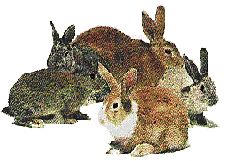
Suppose a newly-born pair of rabbits, one male, one female, are put in a field. Rabbits are able to mate at the age of one month so that at the end of its second month a female can produce another pair of rabbits. Suppose that our rabbits never die and that the female always produces one new pair (one male, one female) every month from the second month on. The puzzle that Fibonacci posed was...
How many pairs will there be in one year?
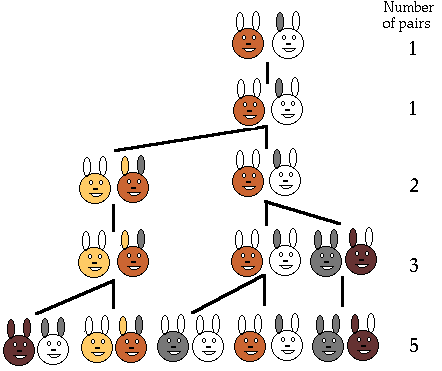
The number of pairs of rabbits in the field at the start of each month is
1, 1, 2, 3, 5, 8, 13, 21, 34, ...
Can you see how the series is formed and how it continues? If not, look at the answer!
The first 300 Fibonacci numbers are here and some questions for you to answer.
Now can you see why this is the answer to our
Rabbits problem? If not,
here's why.
Another view of the Rabbit's Family Tree:
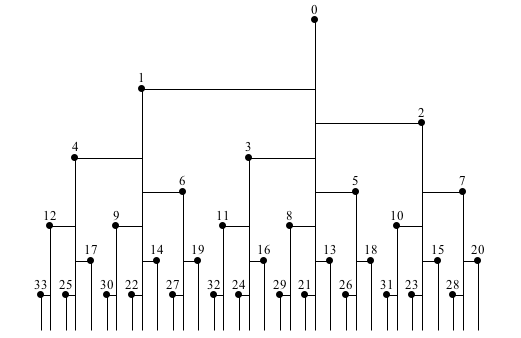 |

|
0, 1, 1, 2, 3, 5, 8, 13, 21, 34, 55, 89, 144, 233, 377, 610, 987 ..More.. ![]()
It seems to imply that brother and sisters mate, which,
genetically, leads to problems. We can get round this by saying that
the female of each pair mates with any male and produces another
pair.
Another problem which again is not true to life, is that each birth is of
exactly two rabbits, one male and one female.
He changes months into
years and rabbits into bulls (male) and cows (females) in problem 175 in his book
536 puzzles and Curious Problems (1967, Souvenir press):

If a cow produces its first she-calf at age two years and after that produces another single she-calf every year, how many she-calves are there after 12 years, assuming none die?This is a better simplification of the problem and quite realistic now.
But Fibonacci does what mathematicians often do at first,
simplify the problem and see what happens - and the series bearing
his name does have lots of other interesting and practical
applications as we see later.
So let's look at another
real-life situation that is exactly modelled by Fibonacci's series - honeybees.
![]() 536 Puzzles and Curious Problems is now out of print, but you may be able to pick up
a second hand version by clicking on this link. It is another collection like
Amusements in Mathematics (above)
but containing different puzzles arranged in sections:
Arithmetical and Algebraic puzzles, Geometrical puzzles,
Combinatorial and Topological puzzles,
Game puzzles, Domino puzzles, match puzzles and "unclassified" puzzles.
Full solutions and index. A real treasure.
536 Puzzles and Curious Problems is now out of print, but you may be able to pick up
a second hand version by clicking on this link. It is another collection like
Amusements in Mathematics (above)
but containing different puzzles arranged in sections:
Arithmetical and Algebraic puzzles, Geometrical puzzles,
Combinatorial and Topological puzzles,
Game puzzles, Domino puzzles, match puzzles and "unclassified" puzzles.
Full solutions and index. A real treasure.
![]() The Canterbury Puzzles, Dover 2002, 256 pages. More puzzles (not in the previous books)
the first section with some characters from Chaucer's Canterbury Tales and other
sections on the Monks of Riddlewell, the squire's Christmas party, the Professors
puzzles and so on and all with full solutions of course!
The Canterbury Puzzles, Dover 2002, 256 pages. More puzzles (not in the previous books)
the first section with some characters from Chaucer's Canterbury Tales and other
sections on the Monks of Riddlewell, the squire's Christmas party, the Professors
puzzles and so on and all with full solutions of course!
There are over 30,000 species of bees and in most of them the bees live
solitary lives. The one most of us know best is the honeybee and it, unusually,
lives in a colony called a hive and they have an unusual Family Tree. In fact,
there are many unusual features of honeybees and in this section we will show
how the Fibonacci numbers count a honeybee's ancestors
(in this section a "bee" will mean a "honeybee").
First, some
unusual facts about honeybees such as: not all of them have two
parents!
![]() In a
colony of honeybees there is one special female called the
queen.
In a
colony of honeybees there is one special female called the
queen.
![]() There are many worker bees who are female too but
unlike the queen bee, they produce no eggs.
There are many worker bees who are female too but
unlike the queen bee, they produce no eggs.
![]() There are some drone bees who are male and do no work.
There are some drone bees who are male and do no work.
Males are produced by the queen's unfertilised eggs, so male bees only
have a mother but no father!
![]() All the females are produced when the queen has mated with a male and so
have two parents. Females usually end up as worker bees but some are
fed with a special substance called royal jelly which makes
them grow into queens ready to go off to start a new colony when the
bees form a swarm and leave their home (a
hive) in search of a place to build a new nest.
All the females are produced when the queen has mated with a male and so
have two parents. Females usually end up as worker bees but some are
fed with a special substance called royal jelly which makes
them grow into queens ready to go off to start a new colony when the
bees form a swarm and leave their home (a
hive) in search of a place to build a new nest.
So female bees have 2 parents, a male and a female whereas male bees have just one parent, a female.
Here we follow the convention of Family Trees
that parents appear above their children, so the latest generations are
at the bottom and the higher up we go, the older people are. Such trees
show all the ancestors (predecessors, forebears, antecedents) of the person
at the bottom of the diagram.
We would get quite a different tree if we listed all the descendants
(progeny, offspring) of a person
as we did in the rabbit problem, where we showed all the descendants of the original pair.
Let's look at the family tree of a male drone bee.
Again we see the Fibonacci numbers :
great- great,great gt,gt,gt
grand- grand- grand grand
Number of parents: parents: parents: parents: parents:
of a MALE bee: 1 2 3 5 8
of a FEMALE bee: 2 3 5 8 13
0, 1, 1, 2, 3, 5, 8, 13, 21, 34, 55, 89, 144, 233, 377, 610, 987 ..More.. ![]()
Make a diagram of Family Tree Names so that "Me" is at the bottom and
"Mum" and "Dad" are above you. Mark in "brother", "sister", "uncle",
"nephew" and as many
other names of (kinds of) relatives that you know. It doesn't matter if you
have no brothers or sisters or nephews as the diagram is meant to show
the relationships and their names.
[If you have a friend who speaks a foreign
language, ask them what words they use for these relationships.]
The Family Tree of humans involves a different sequence to the Fibonacci Numbers. What is this sequence called?
0, 1, 1, 2, 3, 5, 8, 13, 21, 34, 55, 89, 144, 233, 377, 610, 987 ..More.. ![]()
If we take the ratio of two successive numbers in Fibonacci's
series, (1, 1, 2, 3, 5, 8, 13, ..) and we divide each by the number before it,
we will find the following series of numbers:
It is easier to see what is happening if we plot the ratios on a graph:
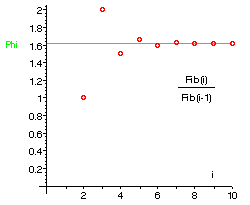
The ratio seems to be settling down to a particular value, which we call the golden ratio or the golden number. It has a value of approximately 1·618034 , although we shall find an even more accurate value on a later page [this link opens a new window] .
0, 1, 1, 2, 3, 5, 8, 13, 21, 34, 55, 89, 144, 233, 377, 610, 987 ..More.. ![]()

 We can make another picture showing the Fibonacci numbers
1,1,2,3,5,8,13,21,.. if we start with two small squares of size 1
next to each other. On top of both of these draw a square of size 2
(=1+1).
We can make another picture showing the Fibonacci numbers
1,1,2,3,5,8,13,21,.. if we start with two small squares of size 1
next to each other. On top of both of these draw a square of size 2
(=1+1).
We can now draw a new square - touching both a unit square and the
latest square of side 2 - so having sides 3 units long; and then
another touching both the 2-square and the 3-square (which has sides
of 5 units). We can continue adding squares around the picture,
each new square having a side which is as long as the sum of the
latest two square's sides. This set of rectangles whose sides are
two successive Fibonacci numbers in length
and which are composed of squares with sides which are
Fibonacci numbers, we will call the
Fibonacci Rectangles.
Here is a spiral drawn in the squares, a quarter of a circle in each square.
The spiral is not a true
mathematical spiral (since it is made up of fragments which are parts of circles and does not go on
getting smaller and smaller)
but it is a good approximation to a kind of spiral that does appear often in nature.
Such spirals are seen in the shape of shells of snails and sea shells and, as we see later,
in the arrangement of seeds on flowering plants too.
The spiral-in-the-squares makes a line from the centre of the spiral increase by a factor of
the golden number in each square. So points on the spiral are 1.618 times as far from the centre
after a quarter-turn. In a whole turn the points on a radius out from the centre
are 1.6184 = 6.854 times further out than when the curve last crossed the same radial line.
Cundy and Rollett (Mathematical Models, second edition 1961, page 70) say that this spiral occurs in snail-shells and flower-heads referring to D'Arcy Thompson's On Growth and Form probably meaning chapter 6 "The Equiangular Spiral". Here Thompson is talking about a class of spiral with a constant expansion factor along a central line and not just shells with a Phi expansion factor.
Several organisations and companies have a logo based on this design,
using the spiral of Fibonacci squares and sometime with the Nautilus shell superimposed.
It is incorrect to say this is a Phi-spiral. Firstly the "spiral" is only an approximation
as it is made up of separate and distinct
quarter-circles;
secondly the (true) spiral increases by a factor Phi every quarter-turn
so it is more correct to call it a Phi4 spiral.
 |
 Everest Community College Basingstoke |
Here are some more posters available from AllPosters.com that are great for your study wall or classroom or to go with a science project. Click on the pictures to enlarge them in a new window.

Nautilus Wampler, Sondra Buy this Art Print at AllPosters.com |

Nautilus Shell Myers, Bert Buy this Art Print at AllPosters.com |

Nautilus Schenck, Deborah Buy this Art Print at AllPosters.com |
The curve of this shell is called
Equiangular or
Logarithmic spirals
and are common in nature, though the 'growth factor' may not always be the golden ratio.
0, 1, 1, 2, 3, 5, 8, 13, 21, 34, 55, 89, 144, 233, 377, 610, 987 ..More.. ![]()
|
|
One plant in particular shows the Fibonacci numbers in the number of "growing points" that it has. Suppose that when a plant puts out a new shoot, that shoot has to grow two months before it is strong enough to support branching. If it branches every month after that at the growing point, we get the picture shown here.
A plant that grows very much like this is the "sneezewort": Achillea ptarmica.
0, 1, 1, 2, 3, 5, 8, 13, 21, 34, 55, 89, 144, 233, 377, 610, 987 ..More.. ![]()
On many plants, the number of petals is a Fibonacci number:
buttercups have 5 petals; lilies and iris have 3 petals; some
delphiniums have 8; corn marigolds have 13 petals; some asters have
21 whereas daisies can be found with 34, 55 or even 89 petals.
The links here are to various flower and plant catalogues:
 Fuchsia |
 Pinks |
 Lily |
 Daisies available as a poster at AllPosters.com |
Here is a passion flower (passiflora incarnata) from the back and front:
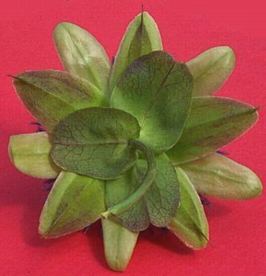
| 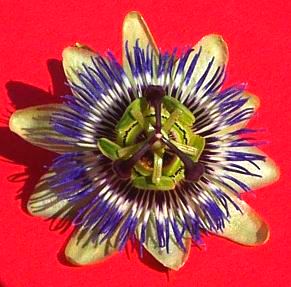
|
|
Back view: the 3 sepals that protected the bud are outermost, then 5 outer green petals followed by an inner layer of 5 more paler green petals |
Front view: the two sets of 5 green petals are outermost, with an array of purple-and-white stamens (how many?); in the centre are 5 greenish stamens (T-shaped) and uppermost in the centre are 3 deep brown carpels and style branches) |
0, 1, 1, 2, 3, 5, 8, 13, 21, 34, 55, 89, 144, 233, 377, 610, 987 ..More.. ![]()
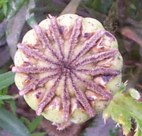 This poppy seed head has 13 ridges on top.
This poppy seed head has 13 ridges on top.

Fibonacci numbers can also be seen in the arrangement of seeds on flower heads. The picture here is Tim Stone's beautiful photograph of a Coneflower, used here by kind permission of Tim. The part of the flower in the picture is about 2 cm across. It is a member of the daisy family with the scientific name Echinacea purpura and native to the Illinois prairie where he lives.
You can have a look
at some more of Tim's wonderful
photographs on the web.

You can see that the orange "petals" seem to form spirals curving both to
the left and to the right. At the edge of the picture,
if you count those spiralling to the right as you go outwards,
there are 55 spirals. A little further towards the centre and you can count 34 spirals.
How many spirals go the other way at these places?
You will see that the pair of numbers (counting spirals in curing left and curving right)
are neighbours in the Fibonacci series.


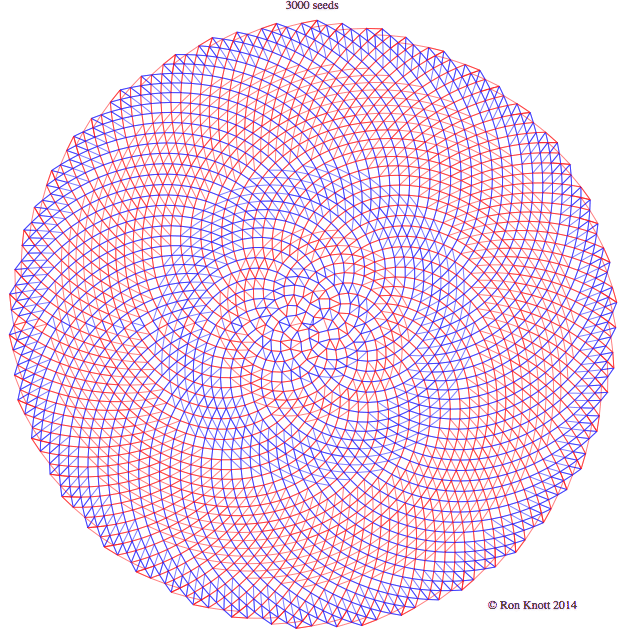
Click on the picture on the right to see it in more detail in a separate window.
| Here is a sunflower with the same arrangement: | This is a larger sunflower with 89 and 55 spirals at the edge: | |
 |
|
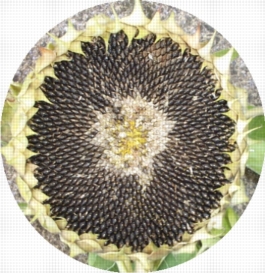
|

Sunflower Buy This Art Print At AllPosters.com | Here are some more wonderful pictures from All Posters (which you can buy for your classroom or wall at home). Click on each to enlarge it in a new window. |
 Sunflower
SunflowerBuy This Poster At AllPosters.com |
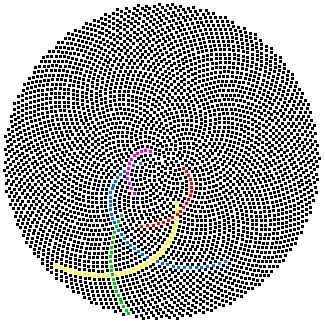
The same happens in many seed and flower heads in nature. The reason seems to be that this arrangement forms an optimal packing of the seeds so that, no matter how large the seed head, they are uniformly packed at any stage, all the seeds being the same size, no crowding in the centre and not too sparse at the edges.
The spirals are patterns that the eye sees, "curvier" spirals appearing near the centre, flatter spirals (and more of them) appearing the farther out we go.
So the number of spirals we see, in either direction, is different for
larger flower heads than for small. On a large
flower head, we see more spirals further out than we do near the centre.
The numbers of spirals in each direction are (almost always) neighbouring Fibonacci numbers!
Click on these links for some more diagrams of
500,
1000 and
5000 seeds.
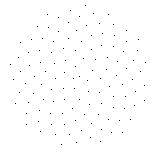 Click on the
image on the right for a Quicktime animation of 120 seeds appearing
from a single central growing point. Each new seed is just phi
(0·618) of a turn from the last one (or, equivalently, there are Phi
(1·618) seeds per turn). The animation shows that, no matter how big
the seed head gets, the seeds are always equally spaced. At all
stages the Fibonacci Spirals can be seen.
Click on the
image on the right for a Quicktime animation of 120 seeds appearing
from a single central growing point. Each new seed is just phi
(0·618) of a turn from the last one (or, equivalently, there are Phi
(1·618) seeds per turn). The animation shows that, no matter how big
the seed head gets, the seeds are always equally spaced. At all
stages the Fibonacci Spirals can be seen.
The same pattern shown by these dots (seeds) is followed if the dots then develop into leaves or branches or petals. Each dot only moves out directly from the central stem in a straight line.
This process models what happens in nature when the "growing tip" produces seeds in a spiral fashion. The only active area is the growing tip - the seeds only get bigger once they have appeared.
[This animation was produced by Maple. If there are N seeds in one frame, then the newest seed appears nearest the central dot, at 0·618 of a turn from the angle at which the last appeared. A seed which is i frames "old" still keeps its original angle from the exact centre but will have moved out to a distance which is the square-root of i.]
![]() Smith College (Northampton, Massachusetts, USA)
has an excellent website :
An Interactive Site for the Mathematical Study
of Plant Pattern Formation which is well worth visiting. It also has a page of links to
more resources.
Smith College (Northampton, Massachusetts, USA)
has an excellent website :
An Interactive Site for the Mathematical Study
of Plant Pattern Formation which is well worth visiting. It also has a page of links to
more resources.
Note that you will not always find the Fibonacci numbers in the number of petals or spirals on seed heads etc., although they often come close to the Fibonacci numbers.
0, 1, 1, 2, 3, 5, 8, 13, 21, 34, 55, 89, 144, 233, 377, 610, 987 ..More.. ![]()
|
Pine cones show the Fibonacci Spirals clearly. Here is a picture
of an ordinary pine cone seen from its base where the stalk connects it to the tree.
Can you see the two sets of spirals? How many are there in each set? |
Here is another pine cone.
It is not only smaller, but has a different spiral arrangement. Use the buttons to help count the number of spirals in each direction] on this pine cone. |
0, 1, 1, 2, 3, 5, 8, 13, 21, 34, 55, 89, 144, 233, 377, 610, 987 ..More.. ![]()
 Also, many plants show the Fibonacci numbers in the
arrangements of the leaves around their stems. If we look down on a
plant, the leaves are often arranged so that leaves above do not hide
leaves below. This means that each gets a good share of the sunlight
and catches the most rain to channel down to the roots as it runs
down the leaf to the stem.
Also, many plants show the Fibonacci numbers in the
arrangements of the leaves around their stems. If we look down on a
plant, the leaves are often arranged so that leaves above do not hide
leaves below. This means that each gets a good share of the sunlight
and catches the most rain to channel down to the roots as it runs
down the leaf to the stem.
Here's a computer-generated image,
based on an African violet type of plant, whereas
this has lots of leaves.
The Fibonacci numbers occur when counting both the number of times we go around the stem, going from leaf to leaf, as well as counting the leaves we meet until we encounter a leaf directly above the starting one.
If we count in the other direction, we get a different number of turns for the same number of leaves.
The number of turns in each direction and the number of leaves met are three consecutive Fibonacci numbers!
For example, in the top plant in the picture above, we have
3 clockwise rotations before we meet a leaf directly
above the first, passing 5 leaves on the way. If we
go anti-clockwise, we need only 2 turns. Notice that
2, 3 and 5 are consecutive Fibonacci numbers.
For the lower plant in the picture, we have 5
clockwise rotations passing 8 leaves, or just
3 rotations in the anti-clockwise direction. This
time 3, 5 and 8 are consecutive numbers in the Fibonacci sequence.
We can write this as, for the top plant, 3/5 clockwise
rotations per leaf ( or 2/5 for the anticlockwise
direction). For the second plant it is 5/8 of a turn per leaf
(or 3/8).
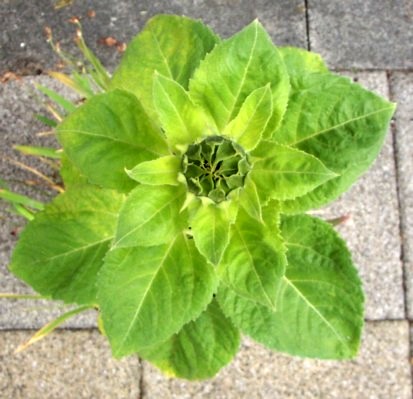
| 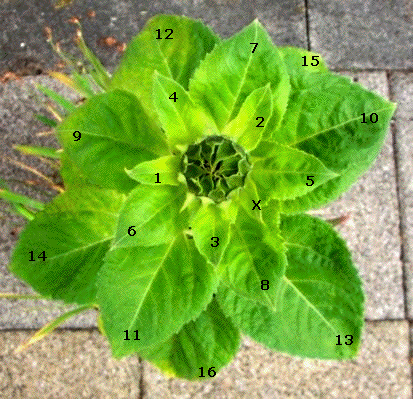
The leaves here are numbered in turn, each exactly 0.618 of a clockwise turn (222.5°) from the previous one. |
| Leaf number | turns clockwise |
| 3 | 1 |
| 5 | 2 |
| 8 | 3 |
One estimate is that 90 percent of all plants exhibit this pattern of leaves involving the Fibonacci numbers.
Some common trees with their Fibonacci leaf arrangement numbers
are:
1/2 elm, linden, lime, grasses
1/3 beech, hazel, grasses, blackberry
2/5 oak, cherry, apple, holly, plum, common groundsel
3/8 poplar, rose, pear, willow
5/13 pussy willow, almond
where t/n means each leaf is t/n of a turn after the last leaf or that there is there are t turns for n leaves.
Cactus's spines often show the same spirals as we have already seen on pine cones, petals and leaf arrangements, but they are much more clearly visible. Charles Dills has noted that the Fibonacci numbers occur in Bromeliads and his Home page has links to lots of pictures.0, 1, 1, 2, 3, 5, 8, 13, 21, 34, 55, 89, 144, 233, 377, 610, 987 ..More.. ![]()

Here is a picture of an ordinary cauliflower. Note how it is almost a pentagon in outline. Looking carefully, you can see a centre point, where the florets are smallest. Look again, and you will see the florets are organised in spirals around this centre in both directions.
How many spirals are there in each direction? | 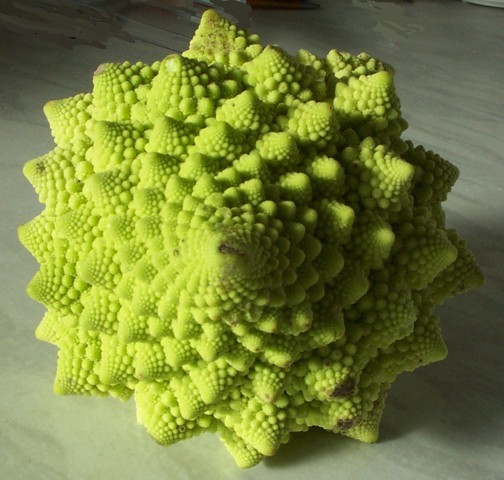
Romanesque Broccoli/Cauliflower (or Romanesco) looks and tastes like a cross between broccoli and cauliflower. Each floret is peaked and is an identical but smaller version of the whole thing and this makes the spirals easy to see.
How many spirals are there in each direction?
These buttons will show the spirals more clearly for you to count (lines are drawn between the florets): |
 Chinese leaves and lettuce are similar but
there is no proper stem for the leaves. Instead, carefully take
off the leaves, from the outermost first, noticing that they
overlap and there is usually only one that is the outermost each
time. You should be able to find some Fibonacci number
connections.
Chinese leaves and lettuce are similar but
there is no proper stem for the leaves. Instead, carefully take
off the leaves, from the outermost first, noticing that they
overlap and there is usually only one that is the outermost each
time. You should be able to find some Fibonacci number
connections.
0, 1, 1, 2, 3, 5, 8, 13, 21, 34, 55, 89, 144, 233, 377, 610, 987 ..More.. ![]()
Look at your own hand:
 You have ...
You have ...
Is this just a coincidence or not?????
However, if you measure the lengths of the bones in your finger (best seen by slightly bending the finger) does it look as if the ratio of the longest bone in a finger to the middle bone is Phi? Why not measure your friends' hands and gather some statistics?
NOTE: When this page was first created (back in 1996) this was meant as a joke and as something to investigate to show that Phi, a precise ratio of 1.6180339... is not "the Answer to Life The Universe and Everything" -- since we all know the answer to that is 42.
The idea of the lengths of finger parts being in phi ratios was posed in 1973 but two later articles investigating this both show this is false.
Although the Fibonacci numbers are mentioned in the title of an article in 2003, it is actually about the golden section ratios of bone lengths in the human hand, showing that in 100 hand x-rays only 1 in 12 could reasonably be supposed to have golden section bone-length ratios.
Research by two British doctors in 2002 looks at lengths of fingers from their rotation points in almost 200 hands and again fails to find to find phi (the actual ratios found were 1:1 or 1:1.3).
- On the adaptability of man's hand J W Littler, The Hand vol 5 (1973) pages 187-191.
- The Fibonacci Sequence: Relationship to the Human Hand Andrew E Park, John J Fernandez, Karl Schmedders and Mark S Cohen Journal of Hand Surgery vol 28 (2003) pages 157-160.
- Radiographic assessment of the relative lengths of the bones of the fingers of the human hand by R. Hamilton and R. A. Dunsmuir Journal of Hand Surgery vol 27B (British and European Volume, 2002) pages 546-548
[with thanks to Gregory O'Grady of New Zealand for these references and the information in this note.]
Similarly, if you find the numbers 1, 2, 3 and 5 occurring somewhere it does not
always means the Fibonacci numbers are there (although they could be).
Richard Guy's excellent and readable article on how and why people draw wrong conclusions from
inadequate data is well worth looking at:
0, 1, 1, 2, 3, 5, 8, 13, 21, 34, 55, 89, 144, 233, 377, 610, 987 ..More.. ![]()
A fuchsia has 4 sepals and 4 petals:  |
and sometimes sweet peppers don't have 3 but 4 chambers inside: |
and here are some flowers with 6 petals:
 crocus |  narcissus |  amaryllis |
Here are some more examples of non-Fibonacci numbers:
|
Here is a succulent with a clear arrangement of 4 spirals in one direction and 7 in the other: |
and here is another with 11 and 18 spirals: | whereas this Echinocactus Grusonii Inermis has 29 ribs: |
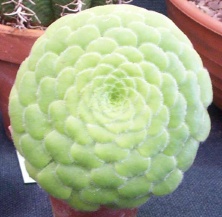 |
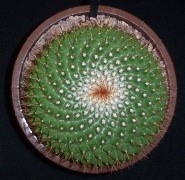
|
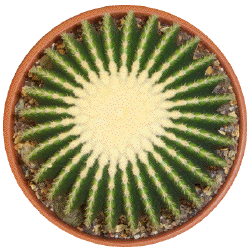
|
So it is clear that not all plants show the Fibonacci numbers!
Another common series of numbers in plants are the Lucas Numbers that start off with 2 and 1 and then, just like the Fibonacci numbers, have the rule that the next is the sum of the two previous ones to give:
2, 1, 3, 4, 7, 11, 18, 29, 47, 76, 123, 199, 322, 521, 843 ..More.. ![]()
But, no matter what two numbers we begin with, the ratio of two successive numbers in all of these Fibonacci-type sequences always approaches a special value, the golden mean, of 1.6180339... and this seems to be the secret behind the series. There is more on this and how mathematics has verified that packings based on this number are the most efficient on the next page at this site.
But the tendency has behind it a universal number, the golden section,which we will explore on the next page.it should be frankly admitted that in some plants the numbers do not belong to the sequence of f's [Fibonacci numbers] but to the sequence of g's [Lucas numbers] or even to the still more anomalous sequences
3,1,4,5,9,... or 5,2,7,9,16,...Thus we must face the fact that phyllotaxis is really not a universal law but only a fascinatingly prevalent tendency.
0, 1, 1, 2, 3, 5, 8, 13, 21, 34, 55, 89, 144, 233, 377, 610, 987 ..More.. ![]()
Trudy is a teacher in California and has some
more information on her book.
(You can even
Buy it online now!)
She also has published
several posters,
including one on
the golden section suitable for
a classroom or your study room wall.
You should also look at her other Fibonacci book too:
0, 1, 1, 2, 3, 5, 8, 13, 21, 34, 55, 89, 144, 233, 377, 610, 987 ..More.. ![]()
The Lucas numbers are formed in the same way as the Fibonacci numbers - by adding the latest two to get the next, but instead of starting at 0 and 1 [Fibonacci numbers] the Lucas number series starts with 2 and 1. The other two sequences Coxeter mentions above have other pairs of starting values but then proceed with the exactly the same rule as the Fibonacci numbers. These series are the General Fibonacci series.
An interesting fact is that for all series that are formed from adding the latest two numbers to get the next starting from any two values (bigger than zero), the ratio of successive terms will always tend to Phi!
So Phi (1.618...) and her identical-decimal sister phi (0.618...) are constants common to all varieties of Fibonacci series and they have lots of interesting properties of their own too. The links above will take you to further pages on this site for you to explore. You can also just follow the links below in the Where To next? section at the bottom on each page and this will go through the pages in order. Or you can browse through the pages that take your interest from the complete collection and brief descriptions on the home page. There are pages on Who was Fibonacci?, the golden section (phi) in the arts: architecture, music, pictures etc as well as two pages of puzzles.
Many of the topics we touch on in these pages open up new areas of mathematics such as Continued Fractions, Egyptian fractions, Pythagorean triangles, and more, all written for school students and needing no more mathematics than is covered in school up to age 16.
| There are no earlier topics - this is the first. |
This is the first page on this Topic.
Where to now?
The next page on this topic is ... |
The next Topic is... |